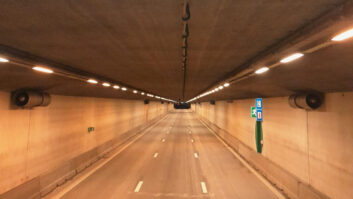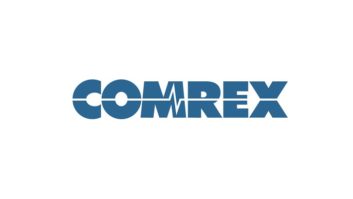Improvements in Filter Combiners
May 1, 2010 12:00 PM, By Derek Small
Insight to IBOC, May 2010

Figure 1. Directional filter
Increasing the IBOC digital sidebands from -20dBc to -10dBc presents more challenges for broadcasters wanting to transmit from one antenna. Currently, at -20dBc, transmitting from one antenna requires digital and analog signals to be combined one of several ways: low-level or common amplification, high-level (couple digital power to transmission line at 10dB), or mid-level, which uses a combination of common amplification and hybrid coupling to minimize FM and digital losses. Common amplification is the most efficient and cost effective way to combine FM and digital sidebands; however, with increased digital sidebands it becomes difficult to use common amplification in a linear mode at powers above 20kW due to peak voltages. Operating the common amp transmitter in a linear mode is required to minimize intermodulation products generated by digital carrier amplification. High-level combining at -10dB is not practical from a cost standpoint due to the increase in size of digital transmitters and the excessive waste.
At the 2009 NAB Show, Myat introduced a patent-pending technique for combining FM and digital sidebands for transmission to a single antenna. The system uses filters to combine the digital sidebands operating in MP1 or MP3 more efficiently than high- and mid-level techniques, and, is ideal for the proposed 10dB digital power increase.
The low-loss IBOC combining system utilizes the typical directional filter circuit seen in Figure 1 and consists of two quadrature hybrids, two identically tuned filters and a reject load. A signal at the narrow band input port is split in quadrature (90-degree phase difference) and passes through the bandpass filters. There it is recombined at the output hybrid and delivered to the output terminal due to the phase relationship of signal at its input terminals. Signals at the broadband input will again be split in quadrature, reflect off the bandpass filter and be delivered back to the hybrid where they are recombined to the output terminal. The transmission response from each input to the output is shown in Figure 1 and color coded. Note the transmission response for each input is similar to the S-parameters of the bandpass filters (i.e. the narrow input is the filter’s transmission response, S21, while the broadband input is the filter’s reflected response, S11 or S22) and makes analysis of the directional filter simple.
There is nothing new about the directional filter layout in Figure 1 other than the type of filtering used to perform the combining function of analog and digital signals for IBOC. Directional filters have been used for years to combine multiple FM stations to one antenna while providing adequate isolation between transmitters. Isolation between inputs is provided by the system directional properties and filter function. Properly functioning hybrids and identical filter S-parameters are key to achieving a directional system � in particular the isolation from narrow input to the broadband input (typical isolation -40dB). The isolation from the broadband input to narrow band input gets additional help from the filter’s rejection, which for classic FM channel combiners is typically around -30dB. This system does not require lossy unreliable circulators for isolation.
— continued on page 2
Improvements in Filter Combiners
May 1, 2010 12:00 PM, By Derek Small
Insight to IBOC, May 2010

Figure 2. Three-section filter response, S21 and S11, 1.6MHz and 800kHz channel separation.
Classic combiners, as stated above, will have approximately 30dB of rejection at the channel to be combined. Illustrated in Figure 2 is the typical frequency response (S21 and S11) of a three-section filter used for combining channels with 1.6MHz separation and the same filter with 800kHz separation. The limited rejection (approx. 7.5dB minimum) for 800kHz spacing results in higher loss (approx. 1.2dB) at the broadband input.
Filter rejection vs. module insertion loss at broadband input to output is plotted in Figure 3 and illustrates the need for high rejection for low insertion loss at the broadband port.

Figure 3. Rejection vs. broadband port loss
The use of filters to combine FM and digital sidebands was discussed early in the rollout of HD Radio, but quickly ignored due to filter order (required for 30dB rejection) and related cost, size and loss issues. A six-section sharp-tuned filter with multiple cross couplings would be required to achieve 30dB rejection at the IBOC MP1 digital sidebands. Six-section pseudo-elliptic function filters are not difficult to design. However, due to narrow bandwidth compared to classic-tuned FM filters, and the higher order, significant losses are incurred.
Higher losses result in low-power handling capability for a given size filter. The six-section sharp-tuned filter and table summarizing loss results is illustrated in Figure 4. The integrated, or average loss of this narrow sharp-tuned filter using high Q, 20″ to 24″ square cavities providing 30dB rejection at the digital sidebands is approximately 1.31dB. Note however, that due to the finite cavity Q there is still significant loss at the sideband inner edges. Using this size cavity in a classic four-section filter with wider bandwidth (400kHz plus) would have approximately 0.25dB loss and handle 30kW. The sharp-tuned filter in Figure 4 using the same cavity geometry can only handle 6.5kW without a lot of additional cooling. It’s easy to see why sharp-tuned filters were quickly disregarded as a solution to combine FM and digital sidebands.

Figure 4. Sharp-tuned filter response for combining digital sidebands to FM.
— continued on page 3
Improvements in Filter Combiners
May 1, 2010 12:00 PM, By Derek Small
Insight to IBOC, May 2010

Figure 5. Mild-tuned, four-section filter response for combining digital sidebands to FM
A directional filter combining solution that purposely exhibits loss was overlooked. Reducing filter order and requiring less rejection at the digital sidebands has less impact on the host FM loss, and digital loss is less than current high-level combining solutions. Figure 5 illustrates one solution using a four-pole filter with a Chebyshev response. Note the integrated loss and variations over the FM (�75kHz) is significantly less than the sharp-tuned filter.
The loss numbers in Figure 5 are calculated using cavity unloaded Qs of 20″ to 24″ square cavities. The higher losses as compared to classic-tuned, four-section filters are due to the narrow bandwidth. Figure 6 illustrates the effect of bandwidth on losses for a four-pole filter.

Figure 6. Mild-tuned, four-section filter response for combining digital sidebands to FM
Derek Small is director of filter products for Myat.
Mississippi Public Broadcasting Adds HD Radio
In June 2009, Mississippi Public Broadcasting culminated a multiyear effort and inaugurated two-channel HD Radio transmission to all eight of its Class C FM analog stations….
IBOC by State Rundown – 2006 – 2010
The HD Radio rollout slowly continues. We compare the state-by-state station counts from 2006 to 2010….
IBOC by State Comparison 2010
Periodically, we have tracked the progress of the HD Radio rollout by state. Through 2008, the number of stations adding HD Radio saw a steady increase….











